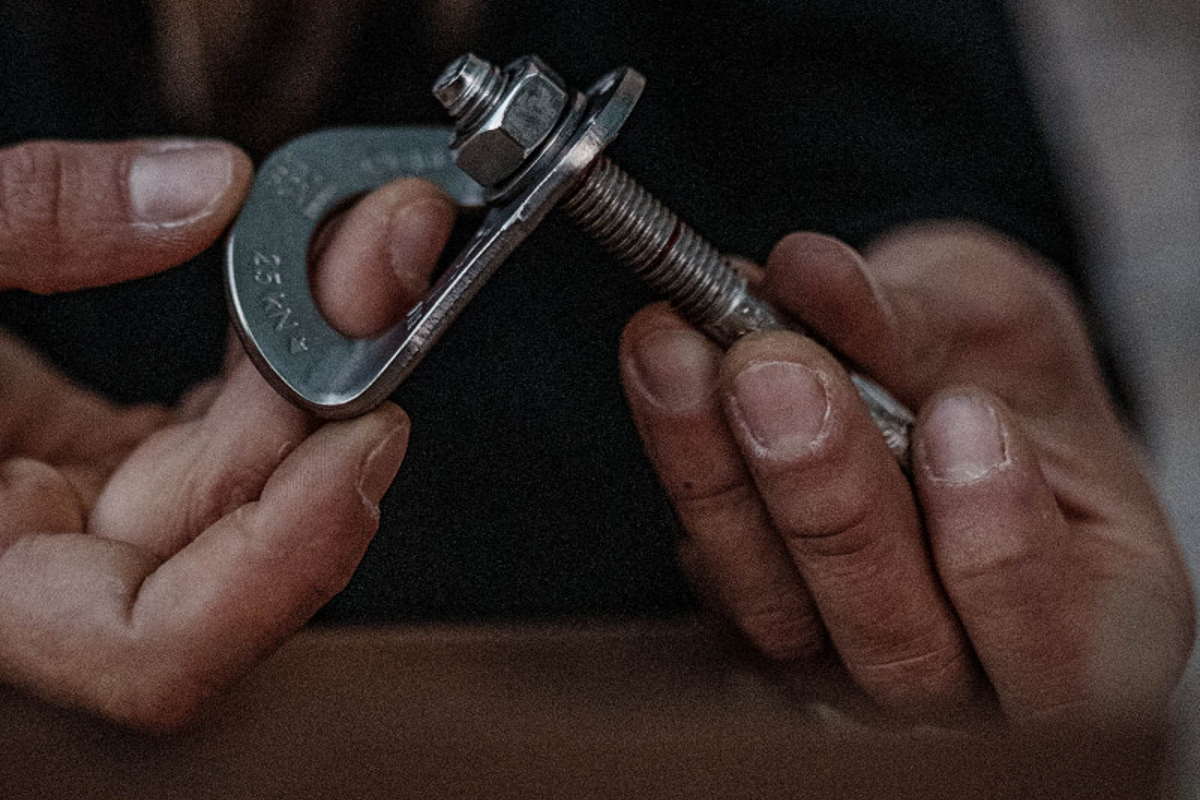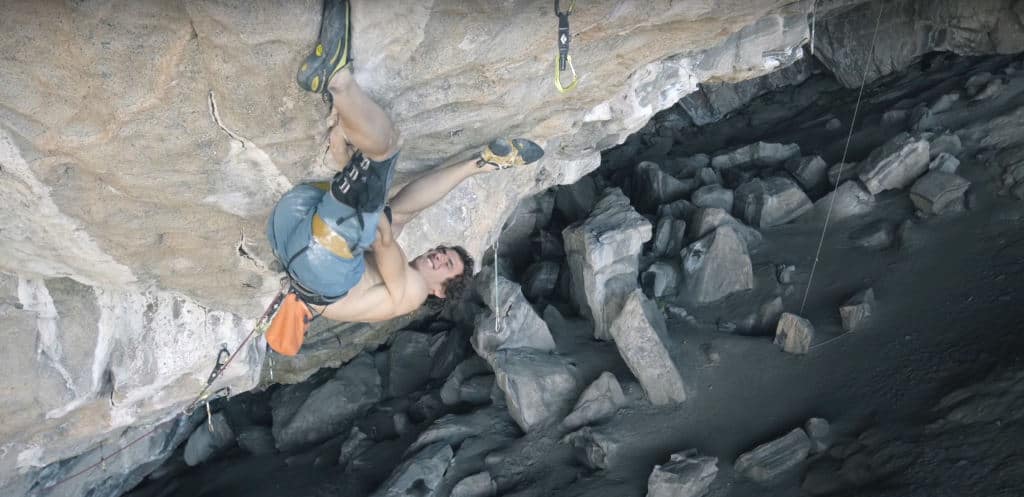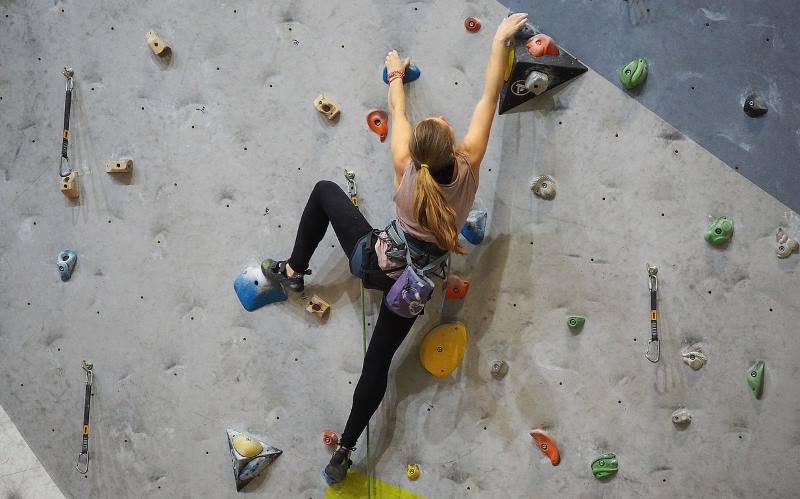More and more people are finding that indoor rock climbing and bouldering are great forms of exercise. Rock climbing for weight loss as part of a healthy lifestyle is definitely possible. We’ll answer your questions and hopefully clear up some misconceptions in this article.
Is Rock Climbing Good For Weight Loss?
Rock climbing and bouldering can be great for losing weight in a healthy and fun way. Both can be done outdoors but nowadays most people will start at a climbing gym. That’s what we’d recommend for beginners as it means can learn in a safe environment.
Losing weight is obviously not a simple thing and also doesn’t need to be the focus of an activity. However, if you’re looking for a form of exercise that’s more engaging than weights or a treadmill – this could be for you.
How Good Is Climbing For Weight Loss?
Rock climbing for exercise is excellent because it combines a strength based workout with a fair amount of cardio. It also involves a lot of stretching, balance, and coordination.
Don’t worry if you aren’t good at any of those! Climbing is great because it’s possible to enjoy and challenge yourself at any level. At a climbing gym you’ll find a wide variety of routes (known as “problems”, “blocs”, or “pitches”) to work on.
These parts together make climbing a good way of losing weight as well as just a fun and engaging thing to do. The mix of different physical and mental aspects make climbing stand out from many other outdoor sports because of the focus and coordination involved.
Without even focusing heavily on one area of it you’ll naturally find yourself getting better at climbing. It’s totally possible to just go and enjoy sessions once or twice a week and get a workout without thinking too much about it.
Is Bouldering Good For Weight Loss?
We’re talking about both bouldering and rock climbing for weight loss in this article as they’re very similar. It’s essentially the same technique and goals over different heights. Most gyms have a bit of both and it’s worth trying each one.
Roped Climbing = Attached to a rope that a partner holds with a safety device. Climbing up to 15-20 meters / 49-65 ft depending on where you are. Falls are safe and much less scary than you think. You’ll start with top-roping.
Bouldering = Climbing only to around 4-4.5 meters / 13-14.5 ft. You climb back down or fall/jump onto really thick protective matting that covers the entire area. No ropes or harness needed. Literally from climbing boulders (chunks of rock) outside.
Bouldering tends to be easier to do because you don’t need a partner. You can also get more bouldering done as well as make up your own routes. Most rock climbing gyms nowadays also have a few auto-belays if you don’t have a climbing partner.
More Climbing Health Articles
– Rock Climbing For Exercise – Is Rock Climbing A Good Workout?
– Rock Climbing Benefits
Does Rock Climbing Burn Calories?
Yes! You’ll find that holding yourself on to a wall is way sweatier than you might think. The physical exertion of pulling is hard enough but the whole body gets a workout as well as the brain.
Sometimes the fear factor is the thing that will push your body into the calorie burning zone. Focusing your entire being on not falling is a fairly intense task. Not to say that climbing is dangerous – it’s actually very safe indoors.
As compared to other forms of cardio like running, cycling, and rowing – climbing is more focused on movement. As a result the sport is better at hitting multiple muscle groups. It does tend to favor the upper body, with the back and arms being key.
Why Is Climbing Better Than Other Workouts?
Instead of repetitive motions on the same machine or just going forward climbing and bouldering are much more engaging. Some of the added benefits of rock climbing are: –
- Strength Based – The back, core, abs and arms get a good workout
- Cardio – Try not to breathe hard when you’re 30 foot off the floor
- Grip – Never drop a $7 coffee again
- Flexibility – Knowing how to do the splits may actually serve a purpose on tricky routes
- Coordination – Ever played twister? Welcome to indoor climbing
- Low Impact – Bouldering might not be, but roped climbing can be a very low impact sport for those with joint problems
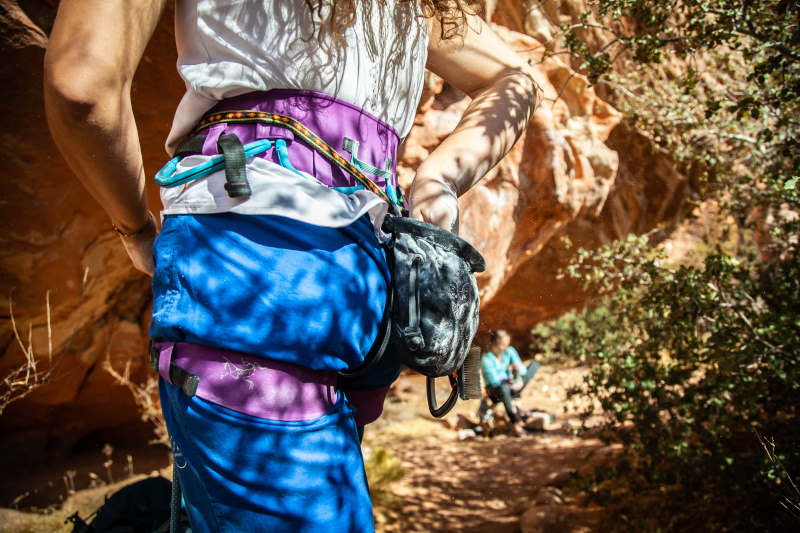
It’s not just physical either!
- Social – Climbers love to compare moves on routes
- Community – There are many local groups to join and lots of people willing to help newbies
- Adventure – Climbing can lead to amazing trips and discoveries
- Mental Health Positives – It’s engaging, focusing, and you have to be focused on the now
- Choice – You choose your route, how hard you work, if you want to talk or just pop in headphones for a sesh
How Do People Lose Weight From Just Climbing?
Rock climbing weight loss is more common than some other activities because you are more likely to actually do it. It’s much easier to motivate yourself to climb because your friends are there, it’s a welcoming place, and there’s a route you’ve been planning to do all week.
Just exercising regularly is much better than an exercise you know you have to do but end up skipping. Some people find they get a climbing gym membership, ditch their old gym, and end up exercising more.
How Many Calories Does Rock Climbing Burn?
There are a few studies on rock climbing that state different figures. One says 8 to 10 calories a minute and anecdotally from various people’s fitness trackers we’ve seen from 5 to 11 calories a minute.
So over an hour that could be from 300 to 660 calories burned through rock climbing. This will vary significantly and depend on a multitude of things from rest time, route difficulty, time on the wall, temperature, and local gravity.
The CDC defines rock climbing as a vigorous activity with a MET value of 6 to 11 depending on the source. MET is a “metabolic equivalent unit”, with one MET being a measure of your bodies metabolic rate and calories burned when your body is at rest.
6 to 11 METs for rock climbing is pretty high with casual cycling being 6 METs, dancing at 4.8, and skiing being from 6-8. So climbing for burning calories is pretty up there as an effective exercise for burning calories.
See here, here, here, here and here for some studies. None provide concrete calories burned information but do measure a few different bits of helpful data. Most showing significant increases in both heart rate and oxygen consumption – aka the markers for cardio.
Best Way To Lose Weight Rock Climbing
First off you, please follow these rules for your own health: –
- Take Rest Days – Take at least one full day off after a climbing session
- Listen To Your Body – If it hurts – stop. Listen to your body
- Avoid Injury – Climbing regularly is better than having to stop because of constant injury
If you’d like to take up climbing to lose weight or as part of a healthy way of life we’d recommend the following:
- Go two or three times a week max – two is perfect
- Find climbing buddies for motivation to go back
- Set realistic goals and expect improvement to slow down and plateau after the initial learning period
- Learn to enjoy climbing
- Use a free climbing training app like Crimp for climbing specific workouts on the wall and floor – Apple – Play Store
- Climb sets of routes in a row, or up and down climb routes for a good aerobic focused session
Is There A Weight Limit For Rock Climbing?
Essentially there is no weight limit for indoors climbing so just go for it. You’ll probably start climbing indoors with top-roping. It’s a safe and easy way to get into climbing without the fear or a big fall. You just need a competent belayer but the easiest way is to book an intro or a learn to climb course.
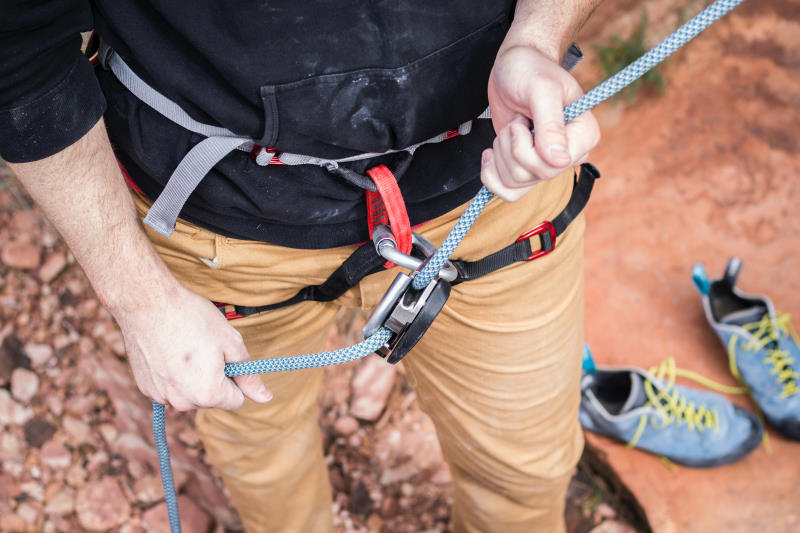
Every piece of climbing safety equipment is rated to withstand extreme forces because we can take big falls that generate a lot of force. Gear failure basically doesn’t happen unless in extreme situations. It’s usually because of sharp rock or rock-fall which won’t be an issue in a gym.
If you are trying roped climbing indoors for the first time you just need to fit into a harness. Most hire harnesses can fit a 49-54 inch waist and 30-35 inch legs. There are also larger harnesses available to buy.
Do I Weigh Too Much to Rock Climb?
The answer is probably no and you’ll find the staff at climbing gyms and other climbers more than supportive. If you are worried at all speak to your local climbing gym and they can advise.
Normally the belayer (person holding the rope) just needs to adjust their technique or strap on weight bags. It’s fairly common even with small weight differences and nothing that will stand out.
When it comes to lead and trad climbing, higher weights will affect things. That doesn’t mean you shouldn’t start climbing outside or that it’s unsafe at a higher than average weight. When you start lead climbing you might want to look at getting an Edelrid Ohm to make falls softer for the belayer.
Do You Need Good Upper Body Strength To Rock Climb?
Nope, rock climbing is way more about using your legs to push than your arms to pull. Forearm and upper body strength play a part but technique will get you much further in your first few months.
Ideally your arms should always be straight so there aren’t using strength. Your lower body moves around with bent knees to get into the right position and the legs push you up to the next hold. Your arms should only bent for a second or two before finding a hold that you can straighten out on and relax again.
What Do I Need To Start?
For now just book an intro session and give it a go. Read up on these articles once you’ve got the bug:
– What To Wear To A Rock Climbing Gym
– Best Beginner Climbing Shoes
– Best Beginner Climbing Harness
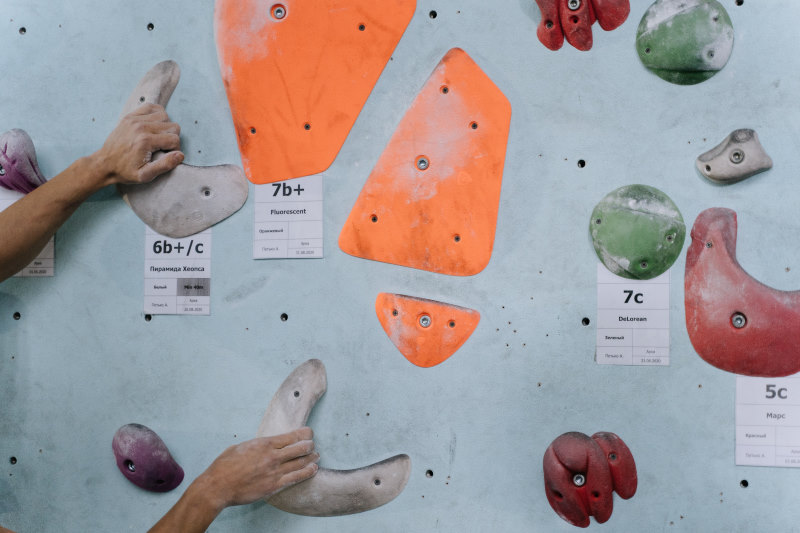
Is There A Weight Limit For Bouldering?
No, there’s no weight limit for bouldering. It’s always worth down climbing instead of jumping to save your ankles but that’s true for people of every weight. Take it at your own pace and decide whether you are comfortable or not with a potential fall.
Falling and knowing what to do if you fall in a weird position is a skill that you’ll learn with time. After your intro course take your time and practice low level falls to get more comfortable with it. There is always an element of risk with bouldering and climbing though so be aware.
Weight Limit For Auto Belays?
Auto belays are the “machine” looking things you’ll find in climbing gyms. You just have to clip in to the rope/ribbon and climb – no partner needed. The auto belay lowers you slowly when you fall by engaging the brake as soon as it feels weight.
There are a few different manufacturers out there with different weight limits. Tru Blue auto belays can hold a climber that weighs up to 150kg or 330lb. Perfect Descent auto belays can hold up to 140kg or 310lb. Honor auto belays are rated to hold up to 150kg or 330lb.
Does How Much You Weigh Affect Climbing Ability?
To a certain degree, yes. However climbing should be a personal thing. Having fun, learning skills, trying new things, and going to new places are all amazing things we get from climbing. Alex Lowe said “the best climber is the one having the most fun“.
Climbing grades and judging yourself based on those numbers is very easy to fall into because of the clear numbers game. It doesn’t have to reflect anything about you though. Competition and motivation to improve can be great but shouldn’t be your main focus.
Famous Climbers Who Aren’t Skinny
While our news feed tends to show climbers that look a certain way – that’s not representative of all climbers. From the gym to the highest level in the sport there are a range of body types.
There are plenty of examples of plus-sized climbers doing rad stuff. Megan Banker is a climber, hiker, and skier living in Portland, Oregon. Drew Hulsey is a sponsored climber who posts a lot of gym and outdoor footage on fun routes.
Johnny Dawes is a complete legend who was diagnosed with Hashimoto’s disease which causes hypothyroidism. His weight has fluctuated but he still clearly loves climbing. Here’s an interview with him about his health and climbing 8b+ at 54.
John Dunne is a climber who’s ascents were sometimes seen as “controversial”. That seems to be mainly because he didn’t look the part of the average climber in the 80’s. Interview and video of John Dunne.
A Word On Climbing + Eating Disorders
This article is for people who are looking for an activity to do that can help with healthy weight loss. It’s not about promoting a certain body shape or type. It’s not saying you have to be a certain weight to be a good climber or to climb at all. Climbing is for everyone and we want you to enjoy it.
However, it would be naive to say that climbers don’t think about weight. In fact there is a lot of discussion nowadays about how how overthinking weight and eating issues has caused harm in the community. It’s also been brushed under the carpet or discussed in a toxic way.
We aren’t going to go into the high level weight debate much. To sum it up though: most modern climbers are at a healthy BMI in the Normal range. They focus on proper nutrition and training over body weight.
Climbing went through an phase in the 80’s and 90’s of very unhealthy eating habits. Being underweight was common at a high level. As a new generation of climbers came in and started performing better at higher weights, the idea that you had to be a certain weight was blown out of the water.
Essentially being underweight saps strength, causes longer recovery times, decreases energy levels and mood. In the very short term some climbers saw positive results from losing weight but soon after found being underweight is a big problem.
Being under a healthy weight has long term physical and mental health effects if not addressed or treated. Some climbers struggle with body issues and eating disorders without thinking it is an issue. Some parts of the community previously encouraged unhealthy weight as the standard.
Now, many have come out publicly to talk about their problems with diet and climbing. If you are struggling with an eating disorder or believe you have an unhealthy relationship with eating – here is a list of resources. There is help and recovery.
